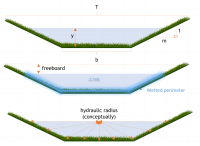Difference between revisions of "Flow in a swale"
Jump to navigation
Jump to search
Jenny Hill (talk | contribs) m |
Jenny Hill (talk | contribs) m |
||
| Line 1: | Line 1: | ||
| − | [[File:Swale_sections.PNG|border]] | + | [[File:Swale_sections.PNG|border|200 px]] |
Flow (''Q'') in an open channel, such as a [[swale]], may be calculated using Manning's equation: | Flow (''Q'') in an open channel, such as a [[swale]], may be calculated using Manning's equation: | ||
<math>Q=VA=\frac{R^{\frac{2}{3}}S^{\frac{1}{2}}}{n}</math> | <math>Q=VA=\frac{R^{\frac{2}{3}}S^{\frac{1}{2}}}{n}</math> | ||
Revision as of 17:25, 3 July 2019

Where:
- Q = the flow in the swale (m3/s)
- A = the cross sectional area of the swale (m2)
- P = the wetted perimeter of the swale (m)
- S = the longitudinal slope (m/m)
- n = Manning's coefficient (dimensionless)

